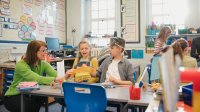Exploring Before Explaining Sparks Learning
New elementary science teachers can build student engagement and enhance learning by using the explore-before-explain approach.
New teachers learn quickly that there are only so many hours in the day, so it’s vital to maximize instruction to achieve the most significant gains possible. An explore-before-explain mindset is a set of beliefs holding that the best learning environments activate students’ ideas and offer them firsthand experiences, learning science by doing science. Once students have developed accurate understandings based on explorations, teachers enhance understanding through explanations that occur at the right time for learners.
Becoming an explore-before-explain teacher requires thinking about teaching and learning in new ways. I’ve found from working with teachers that planning with specific outcomes ensures that we’re promoting more equitable, robust, and memorable experiences. Many teachers who already use hands-on learning find that they can scale their lessons. Others flip their instructional script to explore-before-explain and home in on the most salient part of the lesson to make the best use of instructional time.
Below, I offer four suggestions for curriculum planning and instructional design for becoming an explore-before-explain teacher.
Plan backward
Plan science instruction with the key destinations in mind. Identifying the desired evidence-based claims in planning helps focus teaching on developing students’ conceptual understanding and transfer of learning through purposeful science investigation—the fundamental ideas behind A Framework for K–12 Science Education.
Example: Many elementary teachers have students mix baking soda and vinegar to explore how materials change during a chemical reaction but fall short of having students construct evidence-based claims (a critical element of Understanding by Design and an essential destination of explore-before-explain teaching).
Consider how an explore-before-explain approach could engage students in the active meaning-making needed to promote long-lasting conceptual understanding:
- What data would students collect about how the materials change?
- What evidence-based claim could they construct about the mass of materials before and after the reaction? (See Exploring a Chemical Reaction.)
When teachers purposefully target students’ evidence-based claims in their backward design planning, the explanation occurs in light of understandings that students have constructed through exploration. The above video shows that purposeful and intentional learning by doing from a common experience helps students make the evidence-based claim that mass (weight) is considered during a chemical reaction. Teachers can enhance student ideas by introducing the concept of conservation of mass.
Engage students’ ideas
Students come to us with different experiences and knowledge. Beginning new lessons with students’ ideas and experiences creates a need-to-know situation that activates learning and sets up explorations for students.
Example 1: You might begin a unit on motion by engaging students in predicting the direction a marble travels when dropped from various heights and angles: How could students explore-before-explain and collect data as evidence for their sensemaking? (See Exploring Marble Roll.)
Despite their initial ideas, students can make evidence-based claims that the path an object travels directly results from the forces acting on the object—in this case, gravitational forces pull the object down, but the track determines the direction of the force and motion. Teachers can enhance student understanding by looking at other factors influencing motion (pushes and pulls, friction, etc.).
Example 2: Discrepant events help capture students’ natural inquisitiveness, questions, and problem-solving abilities. For instance, students have misconceptions about weight and size alone determining whether an object sinks or floats.
- What predictions might your students have for whether a watermelon and grape sink or float?
- How does an explore-before-explain sequence allow students to test their predictions about sinking and floating with different everyday materials and help them make evidence-based claims about the mass-to-volume ratio? (See Exploring Watermelon and a Grape.)
Students can make evidence-based claims that sinking and floating are related to both an object’s weight and its size (mass-to-volume ratio, density). After they make evidence-based claims, teachers can help students explain the differences between observations and measurements like mass and volume and physical properties such as the mass-to-volume relationship (e.g., density).
Enhance understanding
Students often need enhancement activities to help them explain the conclusions they’ve made and transfer their learning to new situations. Teachers can plan for the essential scientific vocabulary and terms for concepts and processes related to students’ firsthand experiences that fill gaps from the explorations and are necessary for successful science understanding.
This is when readings, discussions, and lectures become rich learning experiences because they connect ideas and students’ frameworks for understanding.
Example: The Disciplinary Core Ideas, Crosscutting Concepts, and Science and Engineering Practices from the Next Generation Science Standards (NGSS) are good places to start when identifying essential academic vocabulary for developing classroom discussions. In addition, the NSTA outstanding trade book list can effectively introduce academic vocabulary in light of students’ explorations.
Promoting reflection on learning
Our planning should offer students opportunities to think about what they’ve learned and how far they’ve come intellectually—that is, engage in metacognition, which significantly affects learning, a key finding of How People Learn. Evaluation from a learner’s perspective is tied to their sensemaking and offers them a chance to assess how ideas have developed and what strategies will lead to more reliable and valid evidence-based claims.
Example: Students should have opportunities to accurately self-assess using questions such as these:
- How well did I perform? What was most challenging? What grade do I deserve?
- What was most interesting or surprising about this (topic or phenomenon)? What strategies worked well for me during this learning experience? I used to think that __________, but now I understand that __________.
- What will I try next time to improve?
Leading change
The skills, strategies, and behaviors that explore-before-explain teachers must develop may take some time and might not be perfect at first. The most accessible place to start is to find a tried-and-true, hands-on activity that leads to accurate scientific understanding.
Then teachers can shift their instructional script and move exploring to before explaining scientific content, a strategy that benefits both new and experienced teachers.
